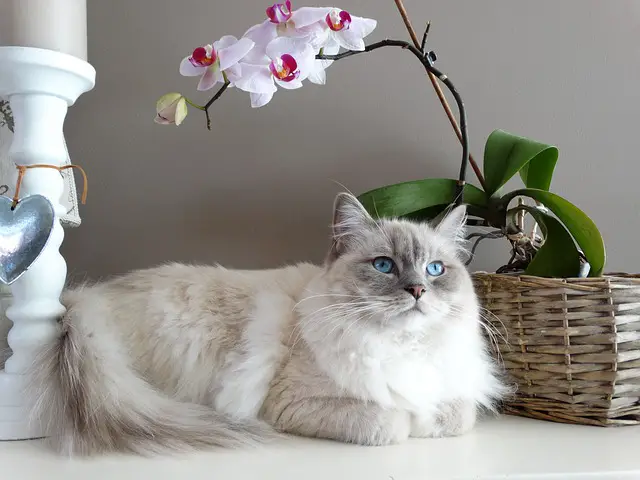Cats – no matter how mischievous they are sometimes, we still love them. They even have a celebration day, created by Colleen Paige, a strong animal welfare advocate. It takes place every year, on the 29th of October.
There isn’t an exact number of cat breeds. For example, Encyclopedia Britannica enlists only fifteen types of cats. On the other hand, the International Cat Association recognizes about seventy-one breeds. Other government and non-government organizations recognize cat breeds ranging between these two lowest and highest numbers.
As a way to celebrate Cat Day and find more about these cute felines, here are 20 facts about 20 amazing cat breeds.
1. Siamese
Siamese cats are widely known thanks to their special features. Their sky blue eyes and elongated, elegant body made them one of the most popular cat breeds in Europe and North America in the 19th century. Probably, they were originally domesticated in Thailand, in the 14th century, where they were treated very well by royal families.
2. Bombay
The Bombay is the only all-black cat. Although the name Bombay corresponds to a city in India, these felines actually originated in the USA. Nikki Horner, the lady who came up with the idea of creating this breed, named it Bombay because she wanted it to look like the black leopard from India. The first successful hybrid kitten was born in 1965 and 14 years later, the International Cat Association recognized the Bombay breed.
3. Sphynx
Sphynx cats distinguish themselves from other felines by their hairless coat. However, some of them are covered by peach fuzz, but it’s barely noticeable. This feature is caused by a mutation in the gene that is responsible for providing hairs with their keratin protein as they emerge from the follicle. As a result, the structure of the hair is weaker and can be damaged and dislodged a lot easier. Throughout the years, Sphynx cats have been perceived as evil felines. Contrary to this popular misconception, the sphynx cat is actually a very friendly, energetic and loving feline who enjoys being the center of attention.
4. Maine Coon
The ancestors of the Maine Coon cat were brought to Maine, USA, by seafarers in the 1850s. They mated with the local shorthair cats. The offsprings were called Maine Coon, due to their tail that resembles the one of a raccoon. Besides their tail, their size is another noticeable feature. The record for the world’s longest house cat belongs to a four feet Maine Coon!
5. Scottish Fold
Scottish Fold cats are, as their name suggests, from Scotland. Their history starts with a particular cat: Susie, who was a white barn cat. She had something special – her folded ears. In 1961, the shepherd William Ross noticed her interesting feature and bought one of her kittens, which he called Snooks. Later on, he bred one of Snooks’s male kittens with a British Shorthair. As a result, the Scottish Fold breed was created.
6. Munchkin
The Munchkin cat is an average sized feline characterized by super short legs and a long spine. Very often, it is seen as the equivalent of a Dachshund. Although short-legged cats could be seen as early as the 1930s, the Munchkin cat is the product of a 1983 discovery in Louisiana, where a music teacher named Sandra Hochenedel rescued two pregnant Munchkins from a Bulldog. She kept one of them and when her kittens were born, she gifted one to her friend Kay LaFrance who bread more on her Louisiana plantations and made it known world-wide.
7. Birman
The Birman is a long and quite large cat. Its origins are unknown. However, there is a mythical story regarding its roots. According to a legend, the feline is descended from a temple cat that belonged to a priest in Ancient Burma (present-day Myanmar). Some raiders attacked the priest, and as he lay dying, the loyal cat kept him company. Later, the cat went through some changes, its fur gaining a golden tint and its eyes becoming a deep blue (the same features as the ones of the goddess the priest worshipped).
8. Oriental
The Oriental cat looks quite similar to the Siamese one, but with a different fur color. It is considered a cat of the extremes: a long triangle-shaped head with tall ears and a long, straight nose. A quite unique thing about this breed is the big number of pattern and color combinations its can have: more than 300.
9. Siberian
As the name suggests, the Siberian’s origins are in Russia and it’s considered its native forest cat. The adaptation to the cold weather conditioned the development of longer hair and a stockier body. Siberian cats have a quite unique personality that resembles the one of dogs. They are also known for their sensitivity. Some Siberians have been noted as being great emotional supporters.
10. Ragdoll
The Ragdoll breed is very similar to the Birman one. This isn’t a surprising thing, because it’s possible that it is the result of the mating between a white Persian cat female and a Birman or Birman-type male. The Ragdoll cat is possibly the most relaxed domestic cat breed. Ragdolls are very tolerant and undemanding. Their personality is actually the thing that determined the name of the breed. When picked up, they become very relaxed and are as floppy as a ragdoll.
READ MORE: Why do Indians hate cats?
11. Devon Rex
The large eyes, prominent cheekbones, short muzzle and big ears give Devon Rex cats an elfin look. The ethereal appearance of these felines is completed by a bubbly personality. Devon Rex cats are very active, playful and courageous.
12. Pixie-Bob
Pixie-Bob cats are characterized by a short tail, a muscular body and the existence of ear tufts. This breed is one of the few who have six or sometimes seven toes on their paws. The name was inspired by the original kitten from the beginning of the development of the breed, who was called Pixie.
13. American Shorthair
As the name suggests, this breed is considered to be the shorthaired cat that is native to the United States. However, the breed wasn’t called like that until 1966. In need for a name to distinguish it from other domestic shorthairs, it was given this one. The first recorded breeding of the American Shorthair took place around 1904. The British Shorthair was one of the parents of this breed, which is probably why these felines look like many other shorthair cats.
14. Abyssinian
Abyssinian cats, also known as “Aby-grabbys”, due to the fact that they tend to take things that grab their interest, are one of the most energetic breeds. Their athleticism and curiosity resulted in a breed that is always doing something, such as jumping, climbing, and exploring.
15. Turkish Angora
Turkish Angora cats get their name from a Turkish city, Ankara (formerly called Angora). These felines are probably the only domestic cats kept and raised in a zoo. In the early 1900s, the government of Turkey in conjunction with the Ankara Zoo began a meticulous breeding program to protect and preserve the pure white Angora cats with blue and amber eyes, a program that still continues.
READ MORE: 20 Amazing Facts About Black Cats: History, Myths, Superstitions
16. Toyger
The toyger is one of the newest cat breeds. Its name is a combination of the words “toy” and “tiger”. The feline was originally created by crossing a Bengal cat with a striped domestic shorthair. Millwood Sharp Shooter is the cat that conditioned this breed’s existence, after his owner, a Bengal cat breeder, noticed tabby markings on his temple.
17. Persian
The Persian cat is a very old breed, originating in the cradle of civilization – Mesopotamia. Its long hair is probably the result of a natural mutation. The feline’s striking appearance caught the attention of many people. For example, during the 19th century, the Persian cat had a special prestige, due to Queen Victoria’s fondness for the breed.
18. Bengal
Besides their luxurious, distinctive coat, Bengal cats distinguish themselves by a large number of skills. They are very intelligent and can learn a big variety of tricks, such as playing fetch or turning on and off light switches. They are also very good at jumping and are able to jump up to three times their own height.
19. LaPerm
The LaPerm is a rex breed known for its curly coat. Even the name of the breed is related to this feature (perm – curly/wavy hairstyle). However, there are some cases when LaPerm cats are born bald or shorthaired and have to wait 2 to 3 years for their curls to appear.
20. Toybob
Toybob is considered one of the smallest cat breeds in the world. It developed in Russia and its history began in 1983, when Kutciy, the kitten who became the foundation of the breed, was born. Despite their kitten-like appearance, Toybobs aren’t miniature cats; they are just small-sized.
If you think about it, cats are some of the most fascinating animals: there are so many breeds, yet each one of them distinguishes itself from the others. With such a big variety of histories, characteristics and personalities, there’s no doubt why cats are loved by so many people!
Now watch the video presentation:
Sources: Days of the Year, Catify, Wikipedia, Rover, PrettyLitter, Science Focus, Hill’s Pet, Purina, Cattime, ASPCA, Catological, Catster, Mental Floss, Petfinder, All About Cats, Vet Street, The Spruce Pets, Mom



